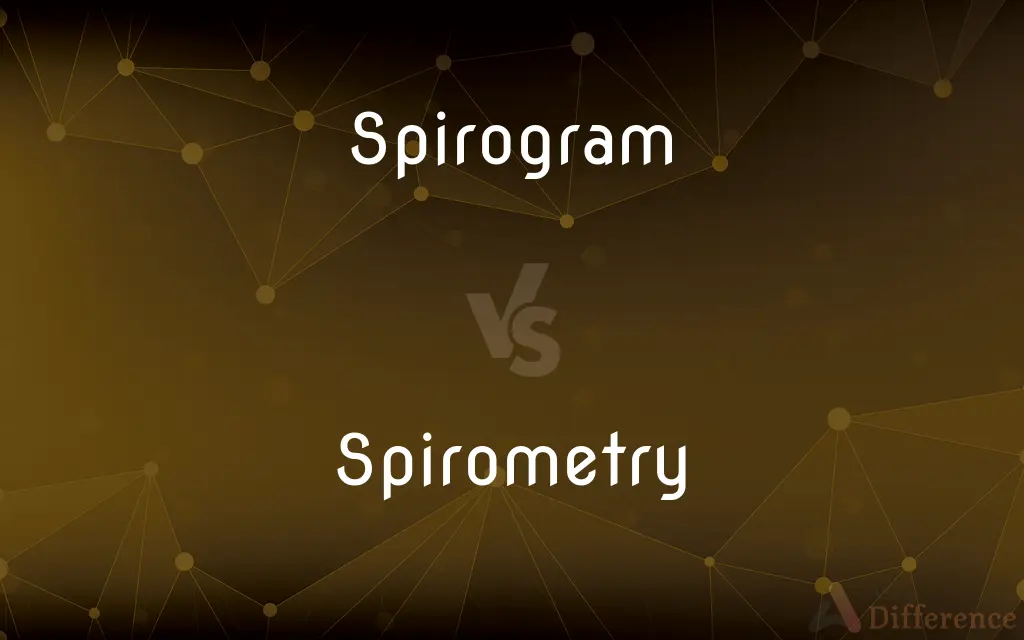Spirogram vs. Spirometry — What's the Difference?
By Tayyaba Rehman & Urooj Arif — Updated on April 24, 2024
A spirogram is a chart recording lung volumes during breathing, while spirometry is the test that measures these volumes and airflow.

Difference Between Spirogram and Spirometry
Table of Contents
ADVERTISEMENT
Key Differences
A spirogram specifically refers to the graphical output that illustrates the volume of air inhaled and exhaled by the lungs over time. This visual representation is critical for assessing lung function. On the other hand, spirometry is the medical test used to generate a spirogram. It involves using a spirometer to capture data during breathing exercises.
Spirometry is a dynamic process where measurements like forced vital capacity (FVC) and forced expiratory volume (FEV1) are taken. These metrics are essential for diagnosing respiratory conditions such as asthma and COPD. Whereas the spirogram is the result of this testing, showing these volumes and rates graphically to help visualize patterns of breathing.
The spirogram can show various breathing patterns, which help in identifying specific respiratory issues. It highlights the efficiency of air movement in and out of the lungs. Conversely, spirometry not only produces these plots but also provides numerical values that are used for medical diagnosis and monitoring.
During spirometry, a patient performs specific breathing maneuvers into the spirometer device. This test requires active participation and can be influenced by the patient's effort. Meanwhile, the spirogram is simply the passive output that records the results of these maneuvers.
While spirometry equipment and protocols can vary, affecting the precision and accuracy of the measurements, the spirogram remains a consistent graphical representation. This makes it an invaluable tool for physicians to interpret the results of the spirometry test.
ADVERTISEMENT
Comparison Chart
Definition
Graphical record of lung volumes over time
Test that measures lung volumes and airflow
Purpose
Visualize breathing patterns
Diagnose and monitor respiratory conditions
Method
Output from spirometry
Uses a spirometer to perform breathing tests
Usage
Assessment and analysis
Diagnostic testing
Dependence
Dependent on spirometry results
Independent, generates spirogram as a result
Compare with Definitions
Spirogram
A visual output of a spirometry test.
After the spirometry test, the spirogram was analyzed to evaluate the patient’s respiratory health.
Spirometry
A procedure used both for initial diagnosis and monitoring of lung diseases.
Regular spirometry tests are crucial for patients with COPD to monitor their lung function over time.
Spirogram
A graphical representation of lung function.
The doctor examined the spirogram to check for any abnormal breathing patterns.
Spirometry
A pulmonary function test that measures lung capacity and airflow.
Spirometry is commonly performed to diagnose asthma.
Spirogram
A plot showing the amount of air inhaled and exhaled during a respiratory test.
The spirogram displayed a reduced lung capacity indicative of restrictive lung disease.
Spirometry
An essential diagnostic tool in pulmonology.
Spirometry results helped confirm the diagnosis of chronic bronchitis.
Spirogram
A tool used to assess pulmonary function by visual means.
The spirogram showed a significant improvement in lung function after the treatment.
Spirometry
A test that requires the use of a spirometer.
Accurate spirometry depends on the proper functioning of the spirometer.
Spirogram
An essential component in respiratory therapy to monitor breathing.
The therapist reviewed the spirogram to adjust the patient's breathing exercises.
Spirometry
A method to evaluate respiratory health by requiring patient's active involvement.
The patient performed several breathing maneuvers during the spirometry session.
Spirogram
A graph of respiratory movement
Spirometry
Spirometry (meaning the measuring of breath) is the most common of the pulmonary function tests (PFTs). It measures lung function, specifically the amount (volume) and/or speed (flow) of air that can be inhaled and exhaled.
Spirogram
A recording of breathing made with a spirograph
Spirometry
An instrument for measuring the volume of air entering and leaving the lungs.
Spirometry
(medicine) The measurement of the volume of air that a person can move into and out of the lungs, using a spirometer.
Spirometry
The act or process of measuring the chest capacity by means of a spirometer.
Common Curiosities
What is a spirogram used for?
A spirogram is used to graphically represent lung volumes and breathing patterns, aiding in the assessment of respiratory health.
Why is spirometry important in diagnosing asthma?
Spirometry is crucial for diagnosing asthma because it measures how well the lungs expel air, helping to identify airflow obstruction.
What are the key measurements taken during spirometry?
Key measurements include forced vital capacity (FVC) and forced expiratory volume in one second (FEV1).
How often should spirometry be done for someone with chronic lung disease?
For chronic conditions like COPD, spirometry is typically recommended at least annually to monitor disease progression.
How is spirometry performed?
Spirometry is performed by having a patient breathe into a spirometer, which measures volumes and airflow during various breathing maneuvers.
Can a spirogram detect lung diseases?
Yes, a spirogram can help detect and assess the severity of lung diseases by showing abnormal breathing patterns.
What does a normal spirogram look like?
A normal spirogram shows a smooth, bell-shaped curve during both inhalation and exhalation, indicating healthy lung function.
How can I prepare for a spirometry test?
Avoid heavy meals and smoking before the test, and wear loose clothing to facilitate easy breathing.
Can spirometry be performed at home?
Home spirometry is possible with portable devices, though it is less common than clinic-based testing.
Are there risks associated with spirometry?
Spirometry is generally safe, though it may cause short-term breathlessness or coughing immediately after the test.
What can cause a poor outcome in spirometry?
Poor technique, patient noncompliance, or faulty equipment can result in inaccurate spirometry results.
Is training required to interpret a spirogram?
Yes, medical training is necessary to accurately interpret spirogram results and diagnose respiratory conditions.
Can children undergo spirometry?
Yes, children old enough to follow instructions can undergo spirometry, typically around age 5 or older.
What is the difference between a spirogram and a peak flow meter?
A spirogram is a detailed plot from a spirometry test, whereas a peak flow meter is a simpler device that measures the maximum speed of exhalation.
How does a spirogram help in the treatment of respiratory diseases?
A spirogram aids in the treatment by providing visual feedback on the effectiveness of prescribed therapies, helping to adjust treatments as needed.
Share Your Discovery

Previous Comparison
Colluvial vs. Alluvial
Next Comparison
Hard vs. RoughAuthor Spotlight
Written by
Tayyaba RehmanTayyaba Rehman is a distinguished writer, currently serving as a primary contributor to askdifference.com. As a researcher in semantics and etymology, Tayyaba's passion for the complexity of languages and their distinctions has found a perfect home on the platform. Tayyaba delves into the intricacies of language, distinguishing between commonly confused words and phrases, thereby providing clarity for readers worldwide.
Co-written by
Urooj ArifUrooj is a skilled content writer at Ask Difference, known for her exceptional ability to simplify complex topics into engaging and informative content. With a passion for research and a flair for clear, concise writing, she consistently delivers articles that resonate with our diverse audience.













































